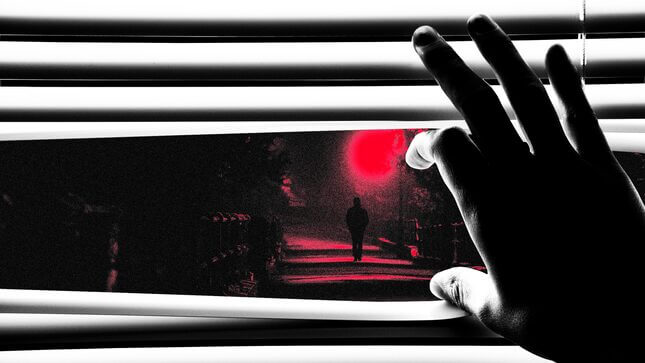
Image: Elena Scotti
In one of the opening scenes of Lifetime’s relentlessly self-aware 2016 reboot of its 1993 camp classic, Mother May I Sleep With Danger?, the film’s main character, a relentlessly culturally-aware college student, opines: “The first Twilight book was good because it made teen sex dangerous again.” The reboot attempts to both mock that idea and find a concept that might still be dangerous-yet-sexy in 2016, changing the made-for-TV movie’s original focus, an abusive relationship, to misandrist lesbian vampires. Each of the film’s iterations is an absurdist, fever-dream manipulation of larger suburban anxieties diluted into television format. The original, along with a spate of 1990s TV movies that eventually made their way to infamy on the Lifetime Network, became a cultural artifact because it tapped into those anxieties with a tawdry earnestness that serves as a perfect time capsule, cataloging white, suburban women’s fears about their communities, their husbands, but perhaps above all else, their teenage daughters.
The “women in peril” narrative is nothing new. Gothic novels like Castle of Otranto and Mysteries of Udolpho regularly trapped teenage heroines in haunted castles then plagued them with sexual threats from older, duplicitous men. But as Victorian cities grew more crowded and polluted, those who could afford to leave fled to the suburbs, safe from the grit of the city but close enough to benefit from its wealth. Ghost stories followed, moving out of far-flung castles and hitting closer to home.
“Ideally, the Victorian suburb engendered domesticity, provided privacy and protection from the gaping masses, promoted respectability, and simulated the country-house lifestyle on a scale that was less grand, less wasteful, and altogether more in line with middle-class values of prudence, propriety, and comfort,” writes Lara Baker Whelan. But expanding suburbs meant an influx of people that the solidly middle-class Victorians believed threatened those very values. This shift had an effect on the era’s ghost stories, which began to focus on once respectable, but now decrepit, haunted suburban homes and mysterious figures with the outward trappings of wealth but sordid, low-income pasts. Unlike early Gothic novels, where the threat came from abroad, in these mid-to-late Victorian horror stories, the haunting was coming from within.
For example, in many of the ghost stories of Charlotte Ridell, a wildly popular though forgotten 19th-century writer, the horror is usually focused on a working-class family moving into a once upper-middle-class home that has fallen into disrepair, now haunted by the ghosts of rich people who lost their money and wail for that loss in the gloomy shells of their ruined fortunes. These ghost stories are a departure from earlier Gothic tales, as the horror seemed to revolve around the specter of city grit taking over spaces meant to provide respite from that disorderliness. The rich ghosts are the victims in these stories, as opposed to the predatory aristocracy in earlier Gothic works.
This idea of the well-to-do as a particular target of crime was prevalent in the heyday of the Lifetime movie as well. In the book Neighborhood of Fear: The Suburban Crisis in American Culture, 1975-2001, author Kyle Riismandel examines what he calls the “productive victimization” of the era during which Ronald Reagan mobilized a white voter base of concerned suburbanites hoping to keep drugs, “welfare queens,” and city-centric chaos out of the orderly suburbs. Highly publicized news stories like the kidnapping of Adam Walsh fanned the flames of that fear, creating a culture of NIMBYs (not in my backyard), hyper-vigilant suburbanites hoping to protect their own children from what they perceived as big-city dangers.
These tensions are on full display in the advent of the Lifetime movie. While the pantheon of 1990s women in peril movies often featured a teenage girl in danger, the intended audience was both young women and their mothers, and the narratives often focused on the dangers the outside world posed to suburban insularity. Films with titles like The Babysitter’s Seduction, No One Would Tell, Death of a Cheerleader, and, of course, the iconic My Stepson, My Lover and Mother, May I Sleep With Danger? usually featured either a mother fighting for the life or safety of her teenage daughter. Just as often, they reverted to the Gothic theme of danger lurking inside the home—a woman realizing the danger lurking in her own home, from the nanny, her husband’s affair partner, her affair partner, or a husband leading a double life.
“We kind of had a push-pull internally, from tabloid to classy. And many times we erred on the tabloid side, or things that were a little more salacious; a little more women-in-jeopardy, because that was really doing it for us in the ratings,” Arturo Interian, Lifetime’s vice president of original movies, told The Washington Post in 2016. “Ratings-wise, we were addicted to the ‘Mother, May I Sleep With Danger?’ sort of thrillers.”
The network found an audience with women by expanding on the crisis stories of after-school specials by making them sexier, more dangerous, but still identifiably and relatably suburban
Beginning with its first original film, 1990’s Memories of Murder, a story about an amnesiac mother who can’t remember why a stranger attempted to kill her family, Lifetime became the corner of cable television where moralistic after-school specials of the 1970s met the Mary Higgins Clark sexy crime thriller. But the format wasn’t relegated to Lifetime. Mother, May I Sleep With Danger was actually an NBC original movie, made in 1993 before the network was home to ratings giants like Friends or ER and was struggling to compete with Monday Night Football. The network found an audience with women by expanding on the crisis stories of after-school specials by making them sexier, more dangerous, but still identifiably and relatably suburban.
-

-

-

-

-

-

-

-

-

-

-

-

-

-

-

-

-

-

-

-

-

-

-

-

-

-

-

-

-

-

-

-

-

-

-

-

-

-

-

-








































